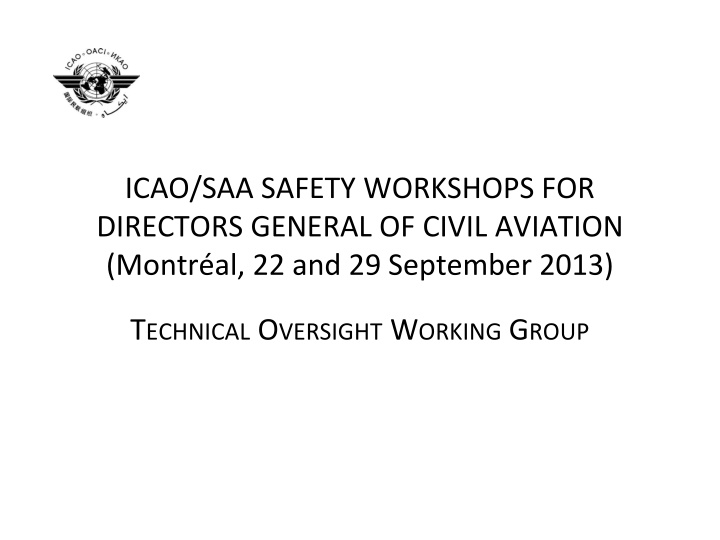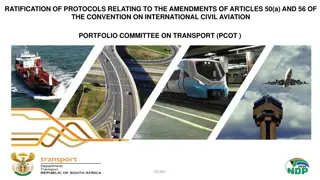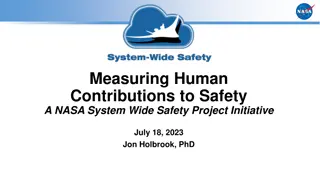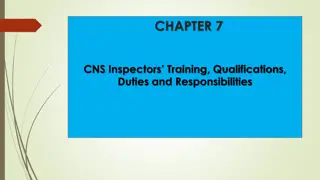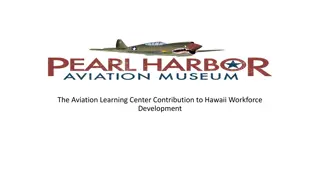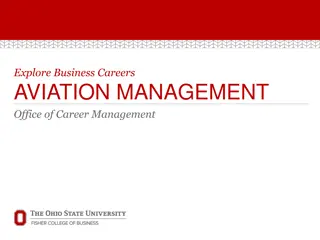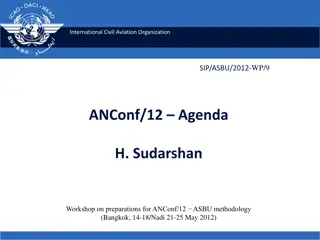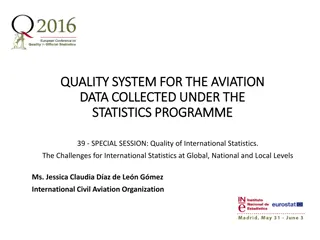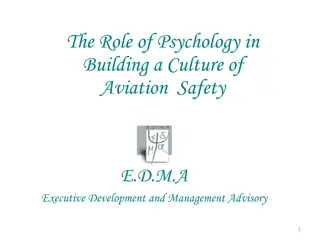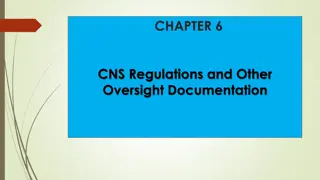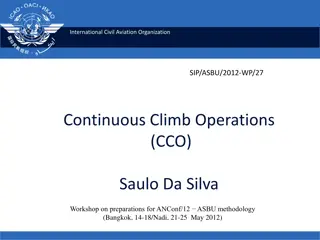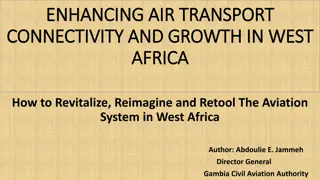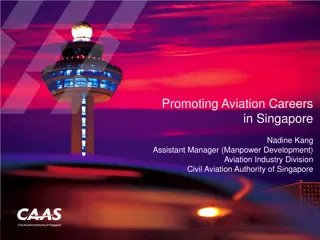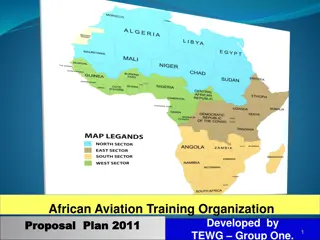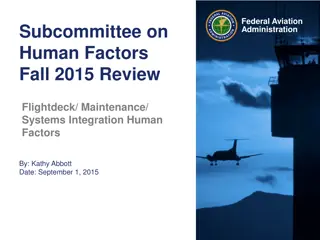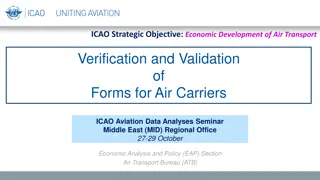ICAO/SAA Safety Workshops for Directors General of Civil Aviation Overview
This overview emphasizes shaping the attitudes of Directors General towards safety oversight in civil aviation, highlighting their ultimate accountability and responsibilities in ensuring global aviation safety. It covers key topics such as safety concepts, state responsibilities, legal frameworks, management of technical experts, and improving safety through key programs and non-technical strategies.
Download Presentation

Please find below an Image/Link to download the presentation.
The content on the website is provided AS IS for your information and personal use only. It may not be sold, licensed, or shared on other websites without obtaining consent from the author.If you encounter any issues during the download, it is possible that the publisher has removed the file from their server.
You are allowed to download the files provided on this website for personal or commercial use, subject to the condition that they are used lawfully. All files are the property of their respective owners.
The content on the website is provided AS IS for your information and personal use only. It may not be sold, licensed, or shared on other websites without obtaining consent from the author.
E N D
Presentation Transcript
ICAO/SAA SAFETY WORKSHOPS FOR DIRECTORS GENERAL OF CIVIL AVIATION (Montr al, 22 and 29 September 2013) TECHNICAL OVERSIGHT WORKING GROUP
General The objective of the course should be to shape the DGs attitude towards safety and make them aware that they (and not their staff) have ultimately accountable for safety oversight in their State. Knowledge and hard work can get you close, it s your attitude that will get you there.
General DGs need to know what they are accountable for, expectations with regard to their responsibilities (e.g. job description, including technical knowledge), and scope of their power Once the DGs understand their accountabilities, other things are more likely to fall in line Highlight the international nature of aviation and how each State fits within the system and plays a part in ensuring global aviation safety
General Explain the main safety concepts / frameworks / components of the system and their inter-relationships. DGs needs to have a clear understanding of the big picture, e.g. Global Aviation Safety Plan Safety Oversight System and 8 Critical Elements State Safety Programme Continuous Monitoring Approach Safety Management Systems
General Go through the key safety responsibilities of a State (and the key approvals that a State is responsible for), including the legal frameworks: Although some DGs may come from a specific technical background, they still need knowledge of other areas Some regulated entities and regulatory processes are less well known (e.g. FSTDs, medical assessors, modification approvals)
General The band may be playing music, but it may be the wrong tune. The DG needs to know what the tune should sound like, and how the different instruments contribute to the tune. How to manage aviation technical experts without necessarily having to be an expert himself/herself When a State has many issues that need to be resolved, what should the DG prioritise?
General Share information on key programmes from other States or regions that can be taken on board to improve safety. Cover the key non-technical points/arguments that can be used to sell aviation safety to other stakeholders within the State (to secure resources).
General Annex 13 principles, e.g. functional separation of accident investigations. Importance of just culture and transparency of information for aviation safety Importance of consulting with technical experts within the CAA Management style, e.g. may need to take into account challenges that a new DG who has a military background may face (e.g. military aviation philosophy may be different from civil aviation, staff may be less likely to challenge)
GASP Provide a clear overview of the GASP Aside from this DG course, ICAO Regional offices could also provide more detailed training How to operationalize the GASP at the State and regional level Discuss the best use of resources to deliver on the timeline contained in the GASP
GASP Global safety priorities Provide an overview of the 3 global safety priorities CFIT, LOC-I and Runway Safety. Highlight how a CAA could contribute to the reduction of each of these global safety priorities. Guide States in identifying areas of higher concern within the State. What role could the RASGs play in this?
Safety Oversight Critical Elements How to create robust internal processes that would assure the DG (e.g. good middle management, reviewing of reports by inspectors, progress/update meetings) that inspectors are carrying out their jobs properly and with integrity Provide an understanding of the application of the 8 critical elements in each of the domains (OPS, AIR, etc.) Areas of highest risk of SSCs, consequences of SSC
Safety Oversight Critical Elements CE 6 (Licensing, Certification, Authorization, Approvals) Appreciation of the scope of a regulatory approval (e.g. for AOCs crew training, crew fatigue, special approvals) and the key safety oversight processes so that DGs know their obligations and implications when they sign certificates
Safety Oversight Critical Elements CE 7 (Surveillance) what are the kinds of resources needed to implement an appropriate surveillance system. What can the DG do to ascertain the kind of competence/skills that an inspector needs to have in order to do a certain job.
Safety Oversight Critical Elements CE 8 (Resolution of safety concerns) Tracking of safety issues that a service provider needs to resolve. Tracking tools and need for transparency (even with the service provider) Indicators that can tell a DG (or the CAA) when surveillance needs to be stepped up Dealing with external pressures when taking enforcement action against a service provider
USOAP Corrective Action Plans Exchange of best practices of actions that a State could take in response to different types of ICAO findings.
Regional Cooperation Regional cooperation Guidance on pooling and sharing of resources for safety oversight and safety improvement at the regional level
State Safety Programme State Safety Programme Suggest to have bite sized information on the SSP concepts. What is the difference between the different systems - SMS, SSP and Quality System. Understanding hazard identification responsibilities of the State and service provider
Other areas - Org? Course should discuss some of the challenge and possible solution to acquire resources, and to recruit and retain good technical personnel. What to look for when recruiting an inspector (e.g. capability and integrity) How to train newly recruited inspectors to have a regulatory mindset How to avoid regulatory capture
Other Suggestions There should be pre-course preparation for the DG before he attends the course. Dashboard aimed specifically for DGs for them to see how their State is doing. (The dashboard should specifically show indicators that that directly linked to the DG s accountabilities) Short presentation targeted at Ministers (or short video clips on the responsibilities of the State in each domain/critical element)
Other Suggestions Regular recurrent training/seminar for DGs, maybe with the assessment from the recurrent training to be taken into consideration in ICAO s safety risk assessment To understand why some service providers are certified (e.g. aerodromes) while some are not (e.g. ANS providers) Sometimes Guidance Material are published very much after the SARP. Makes implementation difficult.
Other Suggestions DGs need direct and focused communications from ICAO on key issues, cannot be expected to read 100- page ICAO documents. Consider a full-fledged diploma/degree course that provides a in-depth understanding of the various aspects of aviation to prepare for a senior management role in aviation. State Government need to be advised on the appropriate profile of a DG candidate, before they appoint a new DG.
